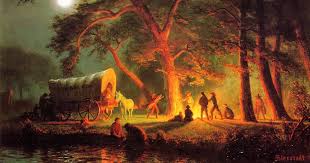Albert Bierstadt, a famed landscape painter known for his paintings of the American West, was born in Germany. Albert was born in Germany and his family immigrated to America in 1831 as a baby. After receiving his education at the National Academy of Design, he traveled extensively through Europe before finally settling in California. Bierstadt is most well-known for his paintings of America’s West, particularly the Yosemite Valley. However, he also painted other places around the world, including parts Africa and New Mexico during his career.
Albert Bierstadt was born in Solingen (Germany) on January 7, 1830. He immigrated to the United States in April 1831 and settled in New Bedford. His work, which depicted the American West’s vast landscapes and dramatic skylines, made him one of America’s most prominent landscape artists during his lifetime.
This article will examine Albert Bierstadt’s artwork and the tragic events that took place during his lifetime. Albert Bierstadt’s paintings were a source of inspiration that gave insight into the American West. Continue reading to learn more about Albert Bierstadt.
Early life
Bierstadt was born in 1830 in Solingen, Germany. His family emigrated to America in 1831. He settled in New Bedford, Massachusetts. He moved to Philadelphia shortly thereafter, where he studied under William Morris Hunt and art until 1855.
Bierstadt traveled extensively throughout Europe and the Middle East during this time. He visited Egypt in 1853, and then again in 1853 on a trip to Europe with other New England artists who were interested in collecting art from these countries.
After exhibiting a large painting of a Swiss scene, Bierstadt received positive reviews from critics. In 1858, Bierstadt was granted honorary membership to the National Academy of Design. New England and New York’s upstate, including the Hudson River Valley, were the first places Bierstadt ever painted. He was a member the Hudson River School.
Critical Acclaim
In the United States, and Europe, Bierstadt was praised by critics. Critics praised Bierstadt’s works, often calling him the “most popular American artist” in his lifetime. Albert Bierstadt’s paintings were displayed at the National Academy of Design and the Art Institute of Chicago.
Bierstadt was a conservationist. One of his paintings was instrumental in the establishment of the first national park in America. Bierstadt’s paintings also helped to raise awareness about the importance of conservation and the value national parks. He was also a member the Sierra Club which enabled him to collaborate with Theodore Roosevelt in establishing Muir Woods National Monument, California.
Bierstadt was a popular artist, but many of his contemporaries were critical of him for over-romantizing his subjects and using too much light. Some reviewers were critical of Bierstadt’s Native American paintings, believing that it “marred” the image of lonely grandeur.
Yosemite Valley: Work
The public and critics loved Albert Bierstadt’s Yosemite Valley paintings. They were criticized by the art community for being too idealistic.
They believed he had painted what they wanted to see, rather than what was actually there. In other words, they felt he was portraying an inaccurate representation of nature and not a realistic one. He was also criticised by conservationists for creating scenes that were not there anymore, since humans have destroyed so much of it through mining and deforestation over the years.
Bierstadt’s Most Famous Paint
His artworks were very popular during his lifetime as well as posthumously. His most well-known painting is arguably “Rocky Mountains, Lander’s Peak”, a painting he did in 1863 to great praise and acclaim.
Bierstadt’s work cemented his position as America’s greatest landscape painter. It was based on sketches and photographs he took during the 1859 survey expedition in the Rocky Mountains. It was made at his New York studio. He depicts a wild, lush setting with a Native American camp at the forefront and majestic, towering mountains as the background. Bierstadt was a standout among other Hudson River School members because of his attention to the country’s Western regions and the trips he made there.
The picture, like many of his works from that period, served as an advertisement for an uncultivated “promised land” which White settlers would eventually conquer. Bierstadt altered certain elements of the landscape to make it more impactful on the viewer than simply portraying it as it was. Bierstadt, for example, highlighted the beauty of the landscape with a almost divine light cast on the waterfall in the middle.
Tragic – Bierstadt lost his wife and his works in a tragic accident
After Rosalie, his wife, was diagnosed with tuberculosis, Bierstadt began spending more time with Rosalie in Nassau, Bahamas, where it was warmer. She died in 1893. He continued to travel back and forth between his New York studio and the west United States and Canada after that.
Bierstadt’s work was still being painted throughout his life. However, critics began to question his art and he came under increasing scrutiny for his overly theatrical style. In 1882, a fire at Irvington, New York destroyed Bierstadt’s studio, taking with it many paintings.
These were some of the saddest experiences Bierstadt faced towards the end his life. He also had to declare bankruptcy due to his extravagant lifestyle.
Legacy
Bierstadt’s focus on the American West uncharted set him apart from his Hudson School peers. He played an important role in introducing Americans to America’s wilderness and wild frontiers. His portrayal of America as the “Promised Land”, influenced American culture and inspired a new generation of explorers to move west.
Bierstadt and the Hudson River School’s aesthetic were outmoded at the end of 19th century. However, American Regionalism artists of 1930s showed their gratitude to the Hudson River School by emphasizing realistic depictions of rural America, even if they were not often idealized. This was during a time when most people had become weary of urban life due to the Great Depression.
Conclusion
Albert Bierstadt was an artist of great stature, but he also had many talents. Although he was a skilled painter, lithographer, engraver, his most well-known works are his landscapes, portraits, and lithography. While his art provided valuable information about the American West and he suffered some tragic events towards the end, it was also very important.















